Module 9 Unit 3 Language in use 课件(共24张PPT)
文档属性
| 名称 | Module 9 Unit 3 Language in use 课件(共24张PPT) |  | |
| 格式 | ppt | ||
| 文件大小 | 2.0MB | ||
| 资源类型 | 教案 | ||
| 版本资源 | 外研版 | ||
| 科目 | 英语 | ||
| 更新时间 | 2022-10-05 16:08:01 | ||
图片预览

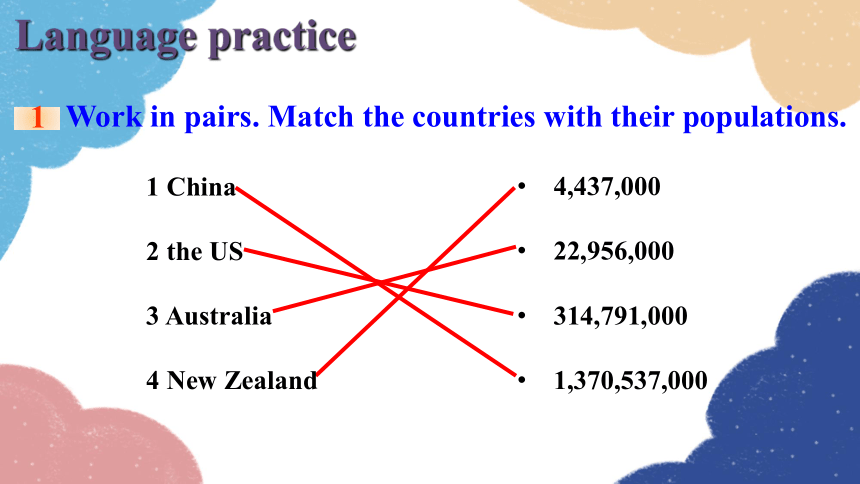
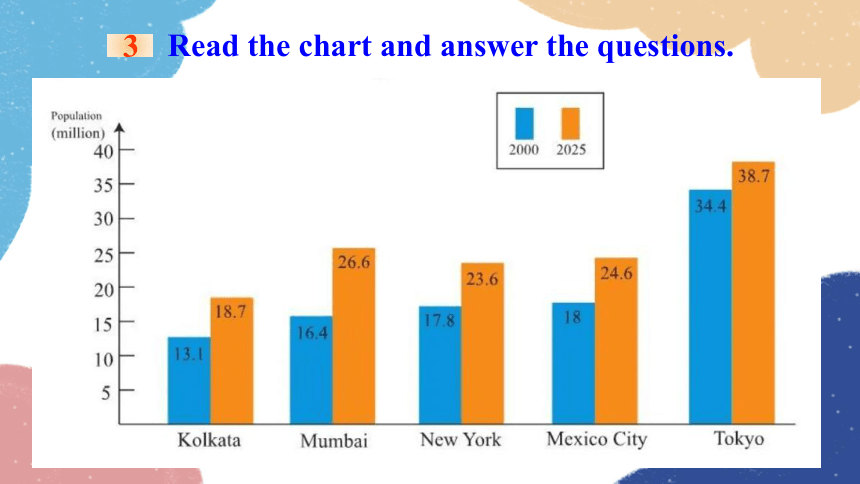
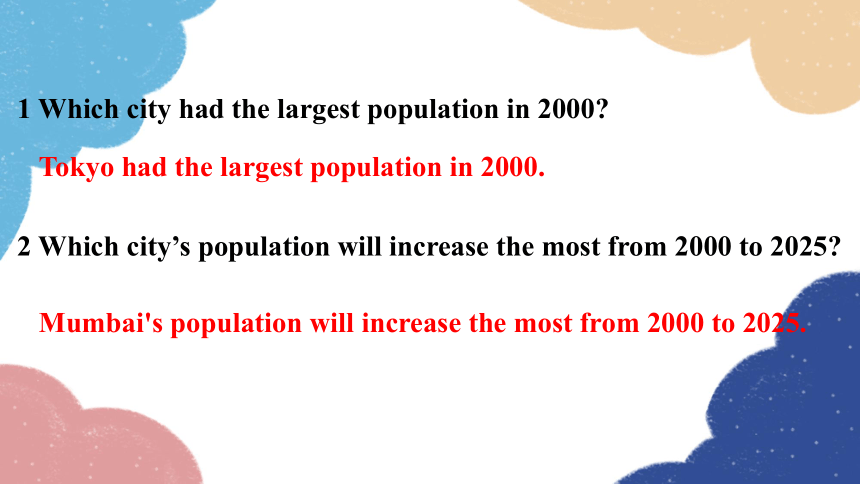

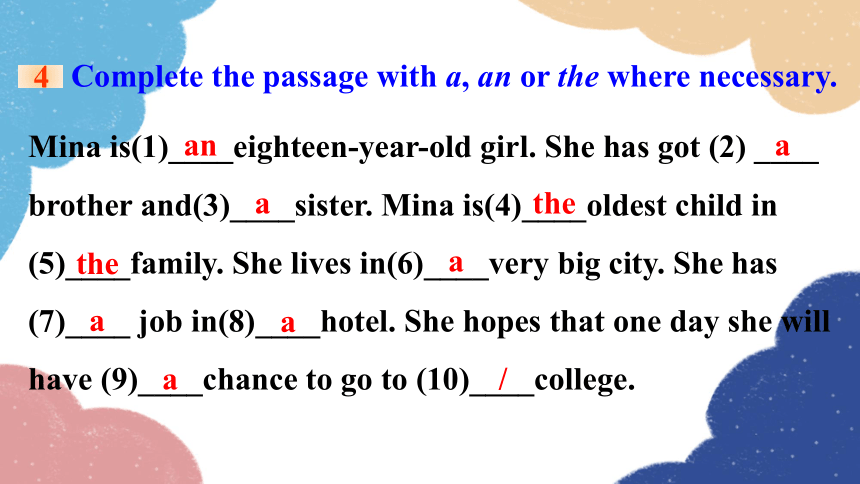

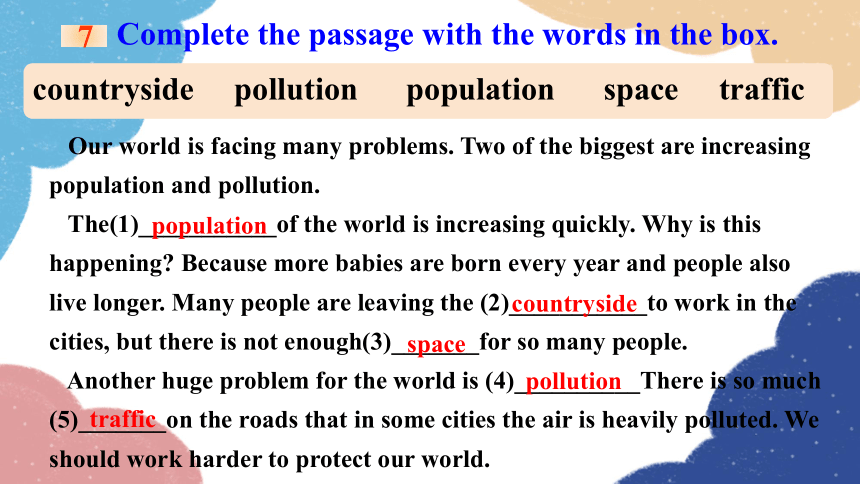

文档简介
(共24张PPT)
Unit 3
Population
Module 9
Language in use
Language practice
4,437,000
22,956,000
314,791,000
1,370,537,000
Work in pairs. Match the countries with their populations.
1
1 China
2 the US
3 Australia
4 New Zealand
Read the chart and answer the questions.
3
1 Which city had the largest population in 2000
2 Which city’s population will increase the most from 2000 to 2025
Tokyo had the largest population in 2000.
Mumbai's population will increase the most from 2000 to 2025.
3 Which city will have a larger increase in its population, New York or Mexico City
4 Which city/cities do you think will have the biggest population problem Why
Mexico City will have a larger increase in its population.
I think Mumbai will have the biggest population problem because its population will increase the fastest.
Complete the passage with a, an or the where necessary.
Mina is(1)____eighteen-year-old girl. She has got (2) ____ brother and(3)____sister. Mina is(4)____oldest child in (5)____family. She lives in(6)____very big city. She has (7)____ job in(8)____hotel. She hopes that one day she will have (9)____chance to go to (10)____college.
4
an
a
a
the
the
a
a
a
a
/
Complete the sentences with the correct form of the words in the box.
1 We believe the schools in Arnwick are very good, and
we are working to make them even_______.
2 Their flat is too large for two people. They want to find
a _______one
3 Anna always talks about her ideas. I think she needs to
listen _______.
4 There are a lot of parks in this city. I think there are
_______parks in a lot of other cities.
few good much small
better
more
smaller
fewer
5
Complete the passage with the words in the box.
Our world is facing many problems. Two of the biggest are increasing population and pollution.
The(1)___________of the world is increasing quickly. Why is this happening Because more babies are born every year and people also live longer. Many people are leaving the (2)___________to work in the cities, but there is not enough(3)_______for so many people.
Another huge problem for the world is (4)__________There is so much (5)_______on the roads that in some cities the air is heavily polluted. We should work harder to protect our world.
countryside pollution population space traffic
population
countryside
space
pollution
traffic
7
Complete the sentences with the expressions in the box.
1 Growing population is a problem__________________.
2 The population of China may grow more slowly____________.
3 The supermarket ___________when a bigger one opened in the town.
4 Usually __________an hour to get there by bus.
5 The town had a lot of pollution in the past but it is ______ a problem_________.
all over the world closed down in the future
it takes not... any more
all over the world
in the future
closed down
it takes
not
8
any more
Around the world
World population and water
With more and more people in the world, more and more water is used. In fact, water use is growing more than twice as fast as the world's population! As a result. getting good, clean water is becoming a problem in many places. A lot of water is polluted and in many areas people have to walk a long way to get clean water for daily use. More than 3.4 million people die each year from drinking and washing with polluted water. So let's do everything we can to stop the pollution and save water.
Work in groups. Prepare to make your graph.
Choose a country or town which interests you. It could be your home town.
Decide the points of time you want to look at – for example, now, ten years ago and ten years from now.
Research the population of your place in those years. Write your notes carefully.
Module task: Making a graph
Make your graph.
Decide how you want to make your graph.
Draw it and colour it. You can also make it on the computer.
Label it clearly.
Write a paragraph to describe your graph.
Present your graph to the class.
1. 冠词是虚词,本身不能单独使用,也没有词义,
它用在名词的前面,帮助指明名词的含义。
2. 冠词分为不定冠词a(an)和定冠词the两种。
Summary
注意:
有些名词前用冠词或不用冠词,其意义有所不同。如:
1) at table 在吃饭 at the table 在桌子旁
2) in class 在上课 in the class 在班级中
3) go to school 去上学 go to the school 到那所学校去
4) go to bed 上床睡觉 go to the bed 到床那边去
5) in front of 在…的前面 in the front of 在…的前部
1. 表示一类人或事物中的“任何 ”一个, 相当于汉语中“一”,但不用于强调数目的概念。
2. 指某人或某物,但不具体说明是何人或何物。
3. 表示单位
4. 表示“一类”
总结:不定冠词的用法
1. 文章中第一次出现的可数名词前用a (an)。下次再出现此名词时。
2. 名词后有表示范围、地点的介词短语限定时。
3. 序数词前表示顺序时
4. 形容词最高级前及only修饰的名词前。
5. 定冠词用于表示世界上独一无二的物体名词前。
总结:定冠词的用法
6. 表示东、南、西、北方的名词前
7. 姓氏的复数形式前时,表示一家人或一姓的夫妇二人
8. the+普通名词构成专有名词。
9. play+乐器表示弹奏时,该乐器名词前加 the。
10. the+形容词(形容词名词化)表示一类人或事物
11. 定冠词the用在江河、海洋、山脉、 湖泊、群岛名称的前面
1. 物质名词和抽象名词前一般不加冠词
2. 表示节日、月份的名词前一般不加the
3. 表示一周中七日的名称前一般不加冠词
4. 学科前和国名、洲名前一般不加冠词
5. 在一些专有名词(地名、节假日)之前不加冠词
总结:零冠词的用法
6. 表示某一概念,而不是某具体工作的部门时,名词前不加冠词
7. 表示三餐的名词前不加冠词
8. 表示交通工具的手段时,用by+名词表示,该名词前不用冠词。
9. 动名词前一般不用冠词。
10. 球类、棋类、游戏名称前不加冠词。
11.名词前有物主代词、指示代词、不定代词、名词所有格或any和no时,均不再用冠词。
12.表示时间或地点的一些介词+名词的词组和一些固定词组中,均不加冠词。
13.家庭成员的称呼、称呼语或只一人担任的职务名词前不用冠词。
1.There’s no air or water on ____ moon.
2. ___ Yellow River is ___ second longest river in ___ China.
3. My mother bought me ___ very nice bike. I like ____ bike
very much.
4. Xiao Ming likes playing ____ basketball,
but he doesn’t like playing _____ piano.
the
The
the
a
the
/
the
/
Practice
填入正确的冠词
5. The students don’t have classes in ___ afternoon on ___ Saturday.
6. I often watch TV in ____ evening.
7. Let’s go out for ____ walk.
8. What would you like for lunch, ____ coffee or ____ milk
the
/
the
a
/
/
填入正确的冠词
1. - Is it ___ English dictionary
- Yes, and it is ___ useful one.
A. a, a B. a, an C. an, a D. an, an
2. There’s ___ dictionary on ___ desk near the window.
A. a, the B. a, a C. the, a D. the, the
3. ___ earth we live on is bigger than ___ moon.
A. The, a B. The, the
C. An, a D. An, the
中考链接
C
A
B
Unit 3
Population
Module 9
Language in use
Language practice
4,437,000
22,956,000
314,791,000
1,370,537,000
Work in pairs. Match the countries with their populations.
1
1 China
2 the US
3 Australia
4 New Zealand
Read the chart and answer the questions.
3
1 Which city had the largest population in 2000
2 Which city’s population will increase the most from 2000 to 2025
Tokyo had the largest population in 2000.
Mumbai's population will increase the most from 2000 to 2025.
3 Which city will have a larger increase in its population, New York or Mexico City
4 Which city/cities do you think will have the biggest population problem Why
Mexico City will have a larger increase in its population.
I think Mumbai will have the biggest population problem because its population will increase the fastest.
Complete the passage with a, an or the where necessary.
Mina is(1)____eighteen-year-old girl. She has got (2) ____ brother and(3)____sister. Mina is(4)____oldest child in (5)____family. She lives in(6)____very big city. She has (7)____ job in(8)____hotel. She hopes that one day she will have (9)____chance to go to (10)____college.
4
an
a
a
the
the
a
a
a
a
/
Complete the sentences with the correct form of the words in the box.
1 We believe the schools in Arnwick are very good, and
we are working to make them even_______.
2 Their flat is too large for two people. They want to find
a _______one
3 Anna always talks about her ideas. I think she needs to
listen _______.
4 There are a lot of parks in this city. I think there are
_______parks in a lot of other cities.
few good much small
better
more
smaller
fewer
5
Complete the passage with the words in the box.
Our world is facing many problems. Two of the biggest are increasing population and pollution.
The(1)___________of the world is increasing quickly. Why is this happening Because more babies are born every year and people also live longer. Many people are leaving the (2)___________to work in the cities, but there is not enough(3)_______for so many people.
Another huge problem for the world is (4)__________There is so much (5)_______on the roads that in some cities the air is heavily polluted. We should work harder to protect our world.
countryside pollution population space traffic
population
countryside
space
pollution
traffic
7
Complete the sentences with the expressions in the box.
1 Growing population is a problem__________________.
2 The population of China may grow more slowly____________.
3 The supermarket ___________when a bigger one opened in the town.
4 Usually __________an hour to get there by bus.
5 The town had a lot of pollution in the past but it is ______ a problem_________.
all over the world closed down in the future
it takes not... any more
all over the world
in the future
closed down
it takes
not
8
any more
Around the world
World population and water
With more and more people in the world, more and more water is used. In fact, water use is growing more than twice as fast as the world's population! As a result. getting good, clean water is becoming a problem in many places. A lot of water is polluted and in many areas people have to walk a long way to get clean water for daily use. More than 3.4 million people die each year from drinking and washing with polluted water. So let's do everything we can to stop the pollution and save water.
Work in groups. Prepare to make your graph.
Choose a country or town which interests you. It could be your home town.
Decide the points of time you want to look at – for example, now, ten years ago and ten years from now.
Research the population of your place in those years. Write your notes carefully.
Module task: Making a graph
Make your graph.
Decide how you want to make your graph.
Draw it and colour it. You can also make it on the computer.
Label it clearly.
Write a paragraph to describe your graph.
Present your graph to the class.
1. 冠词是虚词,本身不能单独使用,也没有词义,
它用在名词的前面,帮助指明名词的含义。
2. 冠词分为不定冠词a(an)和定冠词the两种。
Summary
注意:
有些名词前用冠词或不用冠词,其意义有所不同。如:
1) at table 在吃饭 at the table 在桌子旁
2) in class 在上课 in the class 在班级中
3) go to school 去上学 go to the school 到那所学校去
4) go to bed 上床睡觉 go to the bed 到床那边去
5) in front of 在…的前面 in the front of 在…的前部
1. 表示一类人或事物中的“任何 ”一个, 相当于汉语中“一”,但不用于强调数目的概念。
2. 指某人或某物,但不具体说明是何人或何物。
3. 表示单位
4. 表示“一类”
总结:不定冠词的用法
1. 文章中第一次出现的可数名词前用a (an)。下次再出现此名词时。
2. 名词后有表示范围、地点的介词短语限定时。
3. 序数词前表示顺序时
4. 形容词最高级前及only修饰的名词前。
5. 定冠词用于表示世界上独一无二的物体名词前。
总结:定冠词的用法
6. 表示东、南、西、北方的名词前
7. 姓氏的复数形式前时,表示一家人或一姓的夫妇二人
8. the+普通名词构成专有名词。
9. play+乐器表示弹奏时,该乐器名词前加 the。
10. the+形容词(形容词名词化)表示一类人或事物
11. 定冠词the用在江河、海洋、山脉、 湖泊、群岛名称的前面
1. 物质名词和抽象名词前一般不加冠词
2. 表示节日、月份的名词前一般不加the
3. 表示一周中七日的名称前一般不加冠词
4. 学科前和国名、洲名前一般不加冠词
5. 在一些专有名词(地名、节假日)之前不加冠词
总结:零冠词的用法
6. 表示某一概念,而不是某具体工作的部门时,名词前不加冠词
7. 表示三餐的名词前不加冠词
8. 表示交通工具的手段时,用by+名词表示,该名词前不用冠词。
9. 动名词前一般不用冠词。
10. 球类、棋类、游戏名称前不加冠词。
11.名词前有物主代词、指示代词、不定代词、名词所有格或any和no时,均不再用冠词。
12.表示时间或地点的一些介词+名词的词组和一些固定词组中,均不加冠词。
13.家庭成员的称呼、称呼语或只一人担任的职务名词前不用冠词。
1.There’s no air or water on ____ moon.
2. ___ Yellow River is ___ second longest river in ___ China.
3. My mother bought me ___ very nice bike. I like ____ bike
very much.
4. Xiao Ming likes playing ____ basketball,
but he doesn’t like playing _____ piano.
the
The
the
a
the
/
the
/
Practice
填入正确的冠词
5. The students don’t have classes in ___ afternoon on ___ Saturday.
6. I often watch TV in ____ evening.
7. Let’s go out for ____ walk.
8. What would you like for lunch, ____ coffee or ____ milk
the
/
the
a
/
/
填入正确的冠词
1. - Is it ___ English dictionary
- Yes, and it is ___ useful one.
A. a, a B. a, an C. an, a D. an, an
2. There’s ___ dictionary on ___ desk near the window.
A. a, the B. a, a C. the, a D. the, the
3. ___ earth we live on is bigger than ___ moon.
A. The, a B. The, the
C. An, a D. An, the
中考链接
C
A
B
同课章节目录
- Module 1 How to learn English
- Unit 1 Let's try to speak English as much as possi
- Unit 2 You should smile at her.
- Unit 3 Language in use .
- Module 2 My home town and my country
- Unit 1 It's taller than many other buildings.
- Unit 2 Cambridge is a beautiful city in the east o
- Unit 3 Language in use .
- Module 3 Sports.
- Unit 1 Nothing is more exciting than playing tenni
- Unit 2 This year we training more carefully.
- Unit 3 Language in use .
- Module 4 Planes, ships and trains .
- Unit 1 He lives the farthest from school.
- Unit 2 What is the best way to travel.
- Unit 3 Language in use .
- Module 5 Lao She Teahouse.
- Unit 1 I wanted to see the Beijing Opera.
- Unit 2 It descibes the changes in Chinese society.
- Unit 3 Language in use .
- Module 6 Animals in danger.
- Unit 1 It allows people to get closer to them .
- Unit 2 The WWF is working hard to save them all.
- Unit 3 Language in use .
- Revision module A
- Module 7 A famous story
- Unit 1 Alice was sitting with her sister by the ri
- Unit 2 She was thinking about her cat.
- Unit 3 Language in use .
- Module 8 Accidents
- Unit 1 While the car were changing to red, a car s
- Unit 2 I was trying to pick it up when it bite me
- Unit 3 Language in use .
- Module 9 Population
- Unit 1 The population of China is about 1.37 billi
- Unit 2 Arnwick was a city with 200,000 people.
- Unit 3 Language in use .
- Module 10 The weathe
- Unit 1 It might snow.
- Unit 2 The weather is fine all year round.
- Unit 3 Language in use .
- Module 11 Way of life
- Unit 1 In China ,we open a gift later.
- Unit 2 In England, you usually drink tea with milk
- Unit 3 Language in use .
- Module 12 Help
- Unit 1 What should we do before help arrives?
- Unit 2 Stay away from windows and heavy furniture.
- Unit 3 Language in use .
- Revision module B
